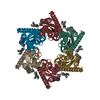+ Open data
Open data
- Basic information
Basic information
| Entry | Database: PDB / ID: 7qey | |||||||||
|---|---|---|---|---|---|---|---|---|---|---|
| Title | human Connexin 26 class 1 hexamer at 90mmHg PCO2, pH7.4 | |||||||||
 Components Components | Gap junction beta-2 protein | |||||||||
 Keywords Keywords | MEMBRANE PROTEIN / Gap junction / Ion Channel / carbon dioxide sensitive | |||||||||
| Function / homology | PHOSPHATIDYLETHANOLAMINE Function and homology information Function and homology information | |||||||||
| Biological species |  Homo sapiens (human) Homo sapiens (human) | |||||||||
| Method | ELECTRON MICROSCOPY / single particle reconstruction / cryo EM / Resolution: 2 Å | |||||||||
 Authors Authors | Brotherton, D.H. / Cameron, A.D. / Savva, C.G. / Ragan, T.J. | |||||||||
| Funding support |  United Kingdom, 2items United Kingdom, 2items
| |||||||||
 Citation Citation |  Journal: Structure / Year: 2022 Journal: Structure / Year: 2022Title: Conformational changes and CO-induced channel gating in connexin26. Authors: Deborah H Brotherton / Christos G Savva / Timothy J Ragan / Nicholas Dale / Alexander D Cameron /  Abstract: Connexins form large-pore channels that function either as dodecameric gap junctions or hexameric hemichannels to allow the regulated movement of small molecules and ions across cell membranes. ...Connexins form large-pore channels that function either as dodecameric gap junctions or hexameric hemichannels to allow the regulated movement of small molecules and ions across cell membranes. Opening or closing of the channels is controlled by a variety of stimuli, and dysregulation leads to multiple diseases. An increase in the partial pressure of carbon dioxide (PCO) has been shown to cause connexin26 (Cx26) gap junctions to close. Here, we use cryoelectron microscopy (cryo-EM) to determine the structure of human Cx26 gap junctions under increasing levels of PCO. We show a correlation between the level of PCO and the size of the aperture of the pore, governed by the N-terminal helices that line the pore. This indicates that CO alone is sufficient to cause conformational changes in the protein. Analysis of the conformational states shows that movements at the N terminus are linked to both subunit rotation and flexing of the transmembrane helices. | |||||||||
| History |
|
- Structure visualization
Structure visualization
| Structure viewer | Molecule:  Molmil Molmil Jmol/JSmol Jmol/JSmol |
|---|
- Downloads & links
Downloads & links
- Download
Download
| PDBx/mmCIF format |  7qey.cif.gz 7qey.cif.gz | 223.7 KB | Display |  PDBx/mmCIF format PDBx/mmCIF format |
|---|---|---|---|---|
| PDB format |  pdb7qey.ent.gz pdb7qey.ent.gz | 174 KB | Display |  PDB format PDB format |
| PDBx/mmJSON format |  7qey.json.gz 7qey.json.gz | Tree view |  PDBx/mmJSON format PDBx/mmJSON format | |
| Others |  Other downloads Other downloads |
-Validation report
| Summary document |  7qey_validation.pdf.gz 7qey_validation.pdf.gz | 980.7 KB | Display |  wwPDB validaton report wwPDB validaton report |
|---|---|---|---|---|
| Full document |  7qey_full_validation.pdf.gz 7qey_full_validation.pdf.gz | 971.4 KB | Display | |
| Data in XML |  7qey_validation.xml.gz 7qey_validation.xml.gz | 35.4 KB | Display | |
| Data in CIF |  7qey_validation.cif.gz 7qey_validation.cif.gz | 48.3 KB | Display | |
| Arichive directory |  https://data.pdbj.org/pub/pdb/validation_reports/qe/7qey https://data.pdbj.org/pub/pdb/validation_reports/qe/7qey ftp://data.pdbj.org/pub/pdb/validation_reports/qe/7qey ftp://data.pdbj.org/pub/pdb/validation_reports/qe/7qey | HTTPS FTP |
-Related structure data
| Related structure data |  13944MC  7qeoC  7qeqC  7qerC  7qesC  7qetC  7qeuC  7qevC  7qewC M: map data used to model this data C: citing same article ( |
|---|---|
| Similar structure data | Similarity search - Function & homology  F&H Search F&H Search |
- Links
Links
- Assembly
Assembly
| Deposited unit | 
| |||||||||||||||||||||||||||||||||||||||||||||||||||||||||||||||||||||||||||||||||||||||||||||||||||||||||||||||||||||||||||
|---|---|---|---|---|---|---|---|---|---|---|---|---|---|---|---|---|---|---|---|---|---|---|---|---|---|---|---|---|---|---|---|---|---|---|---|---|---|---|---|---|---|---|---|---|---|---|---|---|---|---|---|---|---|---|---|---|---|---|---|---|---|---|---|---|---|---|---|---|---|---|---|---|---|---|---|---|---|---|---|---|---|---|---|---|---|---|---|---|---|---|---|---|---|---|---|---|---|---|---|---|---|---|---|---|---|---|---|---|---|---|---|---|---|---|---|---|---|---|---|---|---|---|---|---|
| 1 |
| |||||||||||||||||||||||||||||||||||||||||||||||||||||||||||||||||||||||||||||||||||||||||||||||||||||||||||||||||||||||||||
| Noncrystallographic symmetry (NCS) | NCS domain:
NCS domain segments:
|
 Movie
Movie Controller
Controller











 PDBj
PDBj